
by Rick O'Connor | May 22, 2016
ALL PHOTOS: MOLLY O’CONNOR
Continuing our “ecotour” of the Florida Panhandle along the ICW, this month’s stop is in Walton County. Arguably one of the fastest growing counties in the state, South Walton has become a favorite with many. Relatively undeveloped (as compared to neighboring counties) Walton has an opportunity to develop smarter… and for a lot of it – they have.
Entering Walton County from the west you leave the concentrated tourism of Destin and enter Sandestin. Though still highly developed it slowly gives way to the Point Washington area and more open ground. Here you begin to encounter the famous Dune Lakes. There are no barrier islands along the coastline of Walton County. Instead the Gulf meets the peninsula separating it from Choctawhatchee Bay to the north. Along the Gulf there are magnificent dune fields and freshwater lakes that periodically are open to the Gulf. The lakes are unique in that they have freshwater habitats and tannic waters as well as saltmarsh and seawater when their “mouths” are open. This unique situation provides an ecosystem found in few places in our state. The now famous 30-A travels along these dune lakes across the entire of South Walton. Two state parks, a state forest, a bike trail, and small communities dot this famous trail.
Between 30-A and the Intracoastal Waterway to the north lies the Point Washington State Forest. Here lie acres of well managed pine forest. There are many trails that can be hiked, driven, or traversed by horseback. There are several trails here that are part of state forest’s Trailwalker Program. A major part of this well managed forest is prescribed burning.
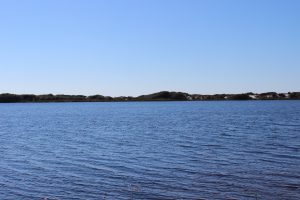
This dune lake at Topsail State Park is one of many “stretched” across South Walton County.
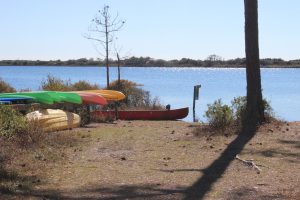
The state park provides kayaks for exploring the dune lake at Topsail. It can be reached by hiking or a tram they provide.
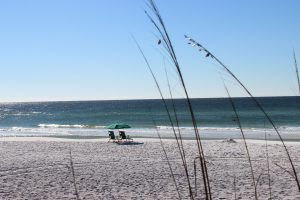
The beautiful beaches of south Walton.

Here is one of the many state forest trails used by hikers and joggers.
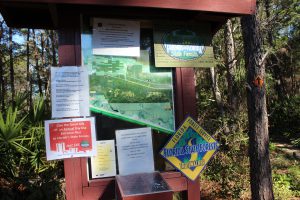
The Florida State Forest hiking trail system provides a lot of information about their trails that is very useful.

The Florida State Trailwalkers Program is a neat way to encourage locals to visit their “natural landscape”. You must hike 10 of the selected trails (on their website provided in this article). There is a log you can download and when you have logged your 10 hikes mail it in. You will receive a free patch indicating you are a “Florida Trailwalker”! This is a great way to explore your “natural Florida”.
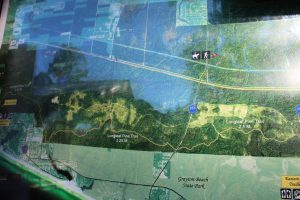
There are trails that cross Point Washington State Forest that can be driven, hiked, or even explored on horseback.
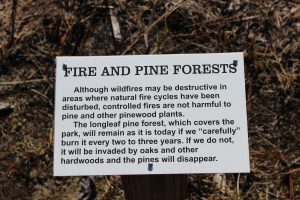
Signage educating the public about the benefits of prescribed burning.
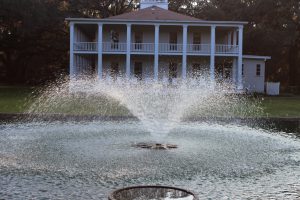
This is the renovated Wesley House at Eden Gardens State Park. The Wesley’s were in the timber industry.
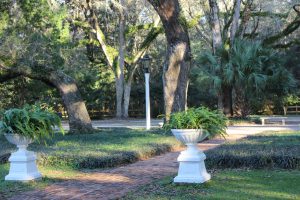
Eden Garden State Park is located north of Highway 98 in south Walton County. It borders the south side of the ICW near Choctawhatchee Bay and is a beautiful getaway.
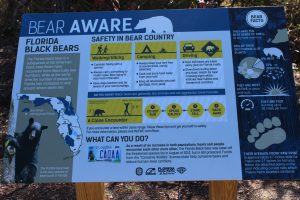
Partly due to successful bear management and partly due to the increase population of humans in the Florida panhandle, bear encounters are in the increase. This sign at Eden Garden State Park provides information on how to deal with an encounter.

From Eden Garden State Park you can look across the bayou to the point where the ICW leaves Choctawhatchee Bay and enters a manmade canal locals refer to as “the ditch”. Notice the prescribed burn occurring across the bay.
PRESCRIBED BURNING
Now days many are aware of the forest management tool we call “prescribed burning”… but not all. For many people, fires are “wild” and the smoke they generate is an unwanted pain. Much of the southeast, particularly Florida, encounter thunderstorms with frequent lighting. These lighting strikes spark fires which burn across acres of forest. The frequency of the lighting storms – and fires – actually kept the understory below the pines cleared and so the fires typically burned low and slow. The result was an understory of grasses and wildflowers that supported a wide variety of species including deer and quail. When he traveled through the southeast in 1775, William Bartram described the longleaf forest as “open and monotonous – going on for miles”. And this was the case… you could literally see up to a mile across the landscape. But this “monotonous” landscape was misleading in that there were thousands of species found here – many feel one of the most biological diverse systems anywhere.
Today 90% of the longleaf has been logged and much of what remains is fire suppressed. For the reasons mentioned above, residents have resisted the natural burns and many species – gopher tortoises, quail, and indigo snakes to name three – have suffered as well. There is a move across the southeast to restore the old longleaf pine forest. These trees produce excellent timber – though it takes longer to grow than the loblolly and slash pine currently grown – and many are managing their property for quail and deer hunting. Yes… the smoke is a problem but the state forestry system plans their burns to reduce the impact it has on the local community as best they can. If you really want to see the benefits of a well-managed pine forest, take a hike through one – it truly is amazing.
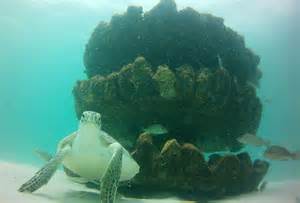
by Laura Tiu | May 8, 2016
Florida has the highest number of sea turtles of any state in the continental US. Three species are common here including loggerhead, green and leatherback turtles. The Federal Endangered Species Act lists all of sea turtles in Florida as either threatened or endangered.
Sea turtle nesting season for the area began May 1, 2016. Adult females only nest every 2-3 years. At 20-35 years old, adult loggerhead and green female turtles return to the beach of their birth to nest. At this age, they are about 3 feet long and 250-300 pounds. The turtles will lay their eggs from May – September, with 50-150 baby turtles hatching after 45-60 days, usually at night. One female may nest several times in one season.
If you happen to see a sea turtle nesting, or nest hatching, stay very quiet, keep your distance, and turn any lights off (no flash photography). You should never try to touch a wild sea turtle. Also, do not touch or move any hatchlings. The small turtles need to crawl on the beach in order to imprint their birth beach on their memory.
During nesting season, it is important to keep the beaches Clean, Dark and Flat. Clean, by removing everything you brought to the beach including trash, food, chairs and toys; dark, by keeping lights off, using sea turtle friendly lighting and red LED flashlights if necessary; and flat, filling up all holes and knocking down sand castles before leaving the beach. If you see anyone harassing a sea turtle or a sea turtle in distress for any reason, do not hesitate to call the Florida Fish and Wildlife Commission hotline at 1-888-404-3922.
There has been encouraging sea turtle news in Florida as a result of the conservation actions being undertaken. There is an increasing number of green turtle nests and a decreasing number of dead turtles found on beaches.
If you want to see a sea turtle and learn more about these fascinating creatures, visit the Navarre Beach Sea Turtle Conservation Center, Navarre, FL, the Gulfarium Marine Adventure Park on Okaloosa Island, Fort Walton Beach, FL, or Gulf World Marine Park in Panama City, FL.
| County |
Beach nesting area (miles) |
Number of loggerhead sea turtle nests |
Number of green sea turtle nests |
Number of leatherback sea turtle nests |
| Franklin |
56 |
608 |
14 |
0 |
| Gulf |
29 |
451 |
14 |
0 |
| Bay |
44 |
170 |
12 |
5 |
| Walton |
30 |
94 |
4 |
3 |
| Okaloosa |
24 |
73 |
6 |
0 |
| Santa Rosa |
7 |
17 |
4 |
0 |
| Escambia |
39 |
86 |
4 |
1 |
Table 1: Data from the 2015 Florida Statewide Nesting Beach Survey available at: www.myfwc.com.
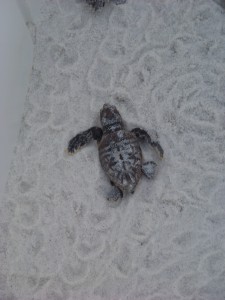
Young loggerhead sea turtle heading for the Gulf of Mexico. Photo: Molly O’Connor
The Foundation for the Gator Nation, An Equal Opportunity Institution.

by Rick O'Connor | Apr 22, 2016
ALL PHOTOS: MOLLY O’CONNOR
As many of you already know each month we have posted articles about nature tourism locations along the Intracoastal Waterway in the Florida Panhandle. This month we visit coastal Okaloosa County.

The Gulfarium in Ft. Walton Beach gives those who do not get a chance to go offshore, or dive, to see some of the unique marine organisms found in the Gulf of Mexico.
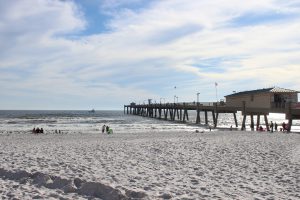
As with many other fishing piers along the panhandle, the Okaloosa Pier not only provides a spot for good fishing but a good spot to watch for marine life and great sunsets.
For years’ tourists have been visiting the beaches of Ft. Walton and Destin. The big draw has been the clean white sand but the area is also known for its really clear water. This clear water has supported a charter fleet that focuses on diving and fishing, but in recent years several operations have included inshore snorkeling and even trawling for marine life for tourists to view.
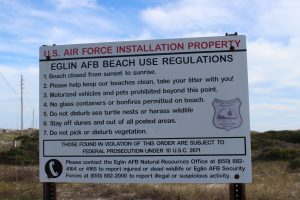
Many feel that you are not allowed on Eglin property. This is true for much of the island under their jurisdiction but there are places where you can park and enjoy the beach – though you must obey their rules.
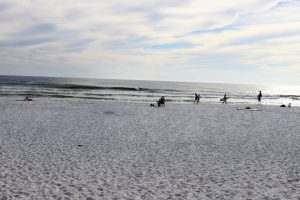
Residents enjoying the beach at one of the public access points on Eglin property.
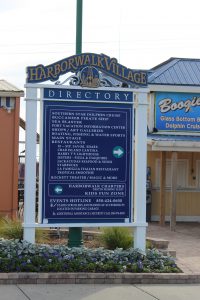
Destin harbor is now home the Haborwalk. There is a lot to see and do on the Haborwalk – and plenty of boat tours.
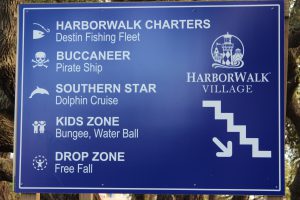
This sign gives the visitor some idea of the different activities that can be found along the Haborwalk.
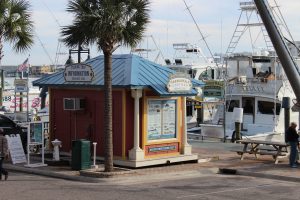
There are numerous types of tours to found along the Harborwalk. Information booths such as this one can help you find what you are looking for.
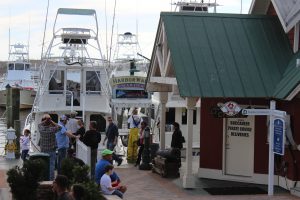
Charters include fishing, diving, snorkeling, and some collect marine life for you to see.
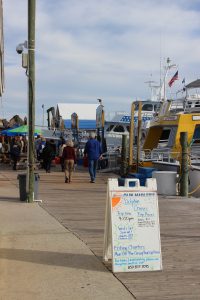
Dolphin cruises are very popular.

There are sailing charters that will allow you to experience the Gulf of Mexico, sunset cruises, and there are some designed with kids in mind.
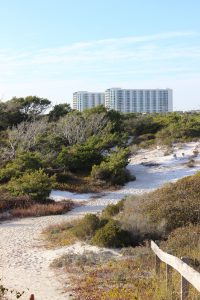
Henderson State Park is on the south side of Highway 98. It has hiking trails, a campground, and access to the Gulf. This is a nice natural location within a very urban area.
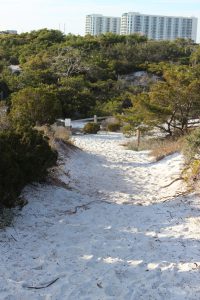
One of the scenic trails where you can explore the natural dune ecosystem in Henderson State Park
ARTIFICIAL REEFS
The natural substrate for most of the northern Gulf of Mexico is quartz sand. There are areas of hard bottom, shell hash, and even some natural reefs but sand dominates the landscape beneath the waves. There is no question that the natural coral reefs of the Florida Keys have been a huge economic engine for that part of the state. The clear, high saline water is filtered by the Everglades and allows much needed light to reach the tiny coral polyps and their symbiotic plant partners, which in turn produce limestone substrate for the polyp colonies to live and grow on.
Locally we have rivers that discharge into the Gulf but the water clarity is still pretty good. The bigger problem for coral development here is the cold winter temperatures and the lack of hard substrate for coral colonies to attach. There are several species of corals, and other encrusting invertebrates and plants, that can tolerate our cooler winters but substrate is still an issue. The answer… artificial substrate… artificial reefs.
Northwest Florida and Alabama have one of the most active artificial reef programs anywhere. Thousands of structures from small concrete pyramids, to chicken coops, to U.S. Navy vessels have been dropped to the bottom. The concept is “build it… and they will come” – meaning the encrusting organisms and eventually larger predatory fishes. At first artificial reefs were just left over rubble and car bodies that were indiscriminately dropped on the Gulf floor. But over years’ marine scientists began to monitor and evaluate what works and what does not and artificial reefs became a science. One question has not been answered… do artificial reefs generate more fish for fishermen – or do they just congregate the existing number of fish into more easily accessible points in the Gulf for easy capture? There is science that supports both arguments… and the debate continues. But if you want to know whether artificial reefs have been an economic success the answer is… yes… by the tens of millions of dollars it has. The charter fleets of Ft. Walton, Destin, Panama City, and Pensacola have all benefited from the artificial reef program. There are numerous structures to dive and many are part of the Florida Panhandle Shipwreck Trail.
If you get a chance take a charter and dive, or fish, one of these interesting and well thought out habitats. Next month we head further east to Walton County and the famous “30A” highway.
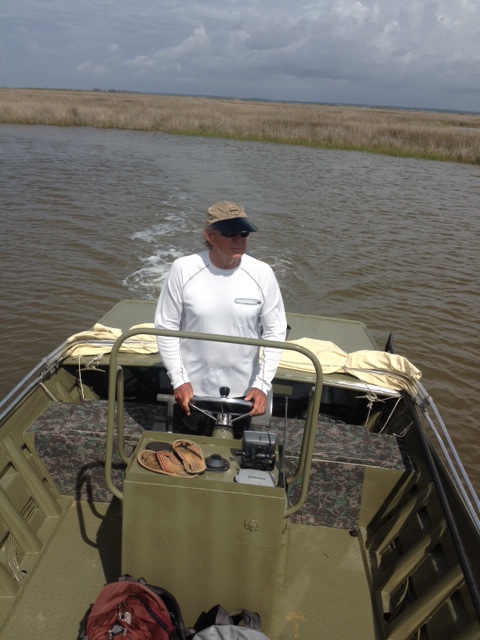
by Rick O'Connor | Apr 22, 2016
Many folks are putting together a “bucket list” of things they would like to do or see before they can no longer do them. For many interested in natural resources there are certain national parks and scenic places they would like to visit. Other natural resource fans have a list of wildlife species they would like to see.

Terrapins inhabit creeks, such as this one, within the expanse of the salt marsh. Here you can see their heads pop up above the water and you may get lucky enough to find one basking.
Photo: Rick O’Connor
Recently I hooked with famed Alabama outdoorsman Jimbo Meador to search for locations to find Alabama turtles. Jimbo has been fishing, hunting, and enjoying the Mobile Bay area all of his life and he now using that knowledge as a guide in a nature-based tourism project. He recently received a call from a group of gentleman from another part of the country who had on their bucket list viewing 1000 reptilian species in their native habitat. In Alabama they were interested in the Black-knobbed Map Turtle, the Alabama Red Belly, and the Diamondback Terrapin. Jimbo has just begun the first module of the Florida Master Naturalist Program and reached out to us for advice on where to find these guys. Luckily, after working with scientists from the University of Alabama at Birmingham, I knew where to find diamondback terrapins – and have a pretty good idea on the others.
These “diamonds of the marsh” – as they are sometimes called – are very elusive creatures. They inhabit muddy bottom creeks within extensive salt marsh habitat all along the Gulf and East coast of the United States. I spent two years searching the Florida panhandle before I found my first live animal. It was one of the odd things though – once you have seen one, you now know what you are looking for and begin to find more.
I took Jimbo to a location near Dauphin Island where about 150 terrapins are believed to exist. Terrapins spend most of their day within creeks that meander through acres of salt marsh. The odd thing is there may be hundreds of creeks within these marshes and the terrapins – for some reason – will select their favorites and hang there. You can spend all day paddling through perfect looking creeks not seeing a head at all… then all of sudden… you enter one creek… not really any different than the others… and there they are.
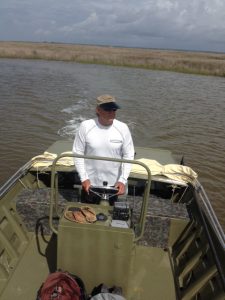
Veteran waterman and outdoor guide, Jimbo Meador, explores the marshes near Dauphin Island for the elusive diamondback terrapin.
Photo: Rick O’Connor
Within these creeks they feed on a variety of shellfish but particularly like the marsh periwinkles. These small snails are the ones that climb the cordgrass and needlerush plants during high tide to avoid their nemesis the blue crab and the diamondback terrapin. Terrapins do crawl out of the water to bask in the sun and have been known to bury in the loose fine mud. Females must find high dry ground to lay her eggs. She may swim as far as 5 miles from her home creek to find a suitable beach. They do like sandy beaches that are open and free of most plants. They emerge onto these beaches during May and June to lay about 7-10 eggs. Most females will lay more than one clutch each season emerging once every 16 days or so. Different from sea turtles – terrapins nest during the daylight hours. Actually the sunnier – the better. Raccoons are a big problem… find and consuming the eggs; on some beaches researchers have reported 90% or more of the nest have been raided by the furry guys. Crows, snakes, and possibly armadillos will take nests as well. If the developing young survive the 60+ days of incubation, they will emerge and head for the grass areas of the marsh… not the water. Here they will spend the first year of their life living more like a land turtle before they make their way to the brackish waters of the salt marsh.
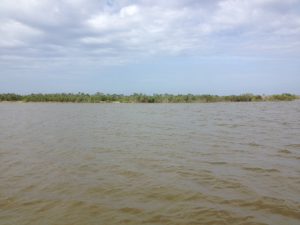
Open sandy beaches, such as the one in this photograph, are the spots females terrapins seek when they are ready to dig a nest.
Photo: Rick O’Connor
These are fascinating creatures and should be on everyone’s natural resource bucket list. The hard effort of finding them really makes doing so very rewarding. On this day Jimbo saw only one head – I did not see any. I have found in my study site that I see more heads in the afternoon (we were out in the morning). I do not know if this is the case at all terrapin nesting sites, but something to consider when looking. Though we did not find many that day he now knows what to look for when searching for them. Next we will have to hunt the Alabama Red Belly Turtle. That is another story for another day.
We will continue this series with other interesting wildlife creatures to “hunt” in the Florida panhandle.

by Rick O'Connor | Mar 25, 2016
All Photos: Molly O’Connor
In this monthly series of highlighting outdoor adventures in the Florida Panhandle, we are visiting locations along the Intracoastal Waterway; from the Alabama State line to the Aucilla River. In January we wrote about Perdido Key, last month we visited Pensacola Beach, this month we move east along Santa Rosa Island to the beach community of Navarre.
Navarre Beach is a relatively quiet community on Santa Rosa Island between Pensacola and Ft. Walton Beach. There are some good places to eat, a new RV campground, and plenty of water/outdoor activities. Navarre Beach became famous in the 1970’s as the location for the film Jaws II. I personally witnessed much of the shooting of the film and it was amazing to see how it all actually all works. The hotel that was used in the film is no longer there but the stories are!
On the Island
There are some great kayak and paddle locations on Navarre Beach. Paddling over the grassbeds and to the east of the Navarre Marine Park you can see a lot of coastal wildlife and great sunsets. You can of course paddle the Gulf as well and maybe take a shot at kayak fishing. You will find local kayak rentals and guides by visiting Naturally EscaRosa website.
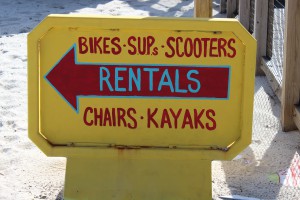
Paddling in a kayak or on a paddleboard is a great way to view wildlife and natural scenes while visiting Navarre Beach.
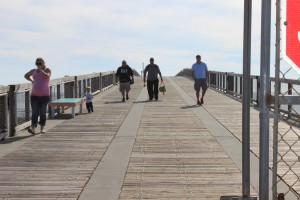
The Navarre Fishing Pier extends over 1500 feet. Not only a great place to fish but a great place to view marine life.
Speaking of fishing, there is the Navarre Beach Fishing Pier which extends 1500 feet out over the Gulf. The pier provides of variety of price options for fishermen of all ages and for $1 you can just walk and enjoy the view. Sharks and sea turtles are often seen from here – and don’t forget the sunsets.
There are two educational interpretive centers on Navarre Beach. The Navarre Beach Marine Science Station is part of the Santa Rosa County School District. They provide programs for elementary, secondary, and dual-enrolled high school-college students. The Station also provides numerous youth camps during the school year and during the summer, as well as providing activities at local community events. To see if they have something going for your young one while you are here visit their website.
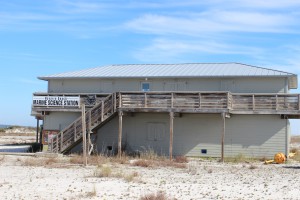
The Navarre Beach Marine Science Station provides education for young and old.
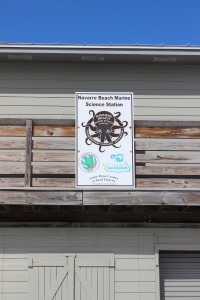
The Navarre Beach Sea Turtle Conservation Center is an educational center that focuses on imperiled marine wildlife but the sea turtle is the star of the show. The center will eventually house an injured sea turtle that can no longer be released but until one arrives, there is plenty to see and learn. Learn more about the center at their website.
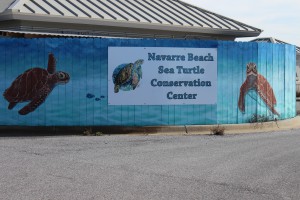
The Navarre Beach Sea Turtle Conservation Center.
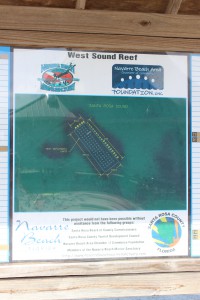
Santa Rosa County also provides a couple of nearshore snorkel reefs for the public. You can find them on both the Gulf and Sound sides.

These day markers are marking two nearshore snorkel reefs on the Sound side of Navarre Beach. They can be accessed from the Navarre Marine Park.
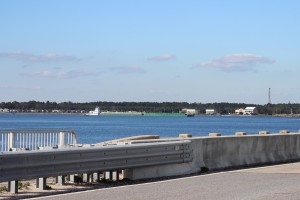
A barge travels beneath the Navarre Beach Bridge as it heads east along the ICW.
Off the island
Actually, you have to leave Santa Rosa at this point. The island between Navarre Beach and Ft. Walton Beach is the property of the United States Air Force.
As you leave Navarre Beach to travel the ICW from the north side, you see the Panhandle Butterfly House on your left at the Highway 98 traffic light. This is a great stop. Viewing live butterflies feeding on native plants in all stages of their lives is a cool sight. There are plenty of volunteers to educate you about native butterflies and there is a pond out back with a lot of turtles and birds to view. It’s a neat and relaxing place.
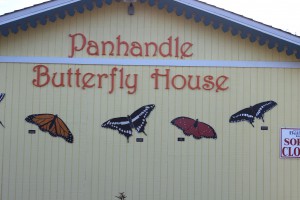
The Panhandle Butterfly House is located just to the west of the traffic light on Highway 98 as you leave Navarre Beach.

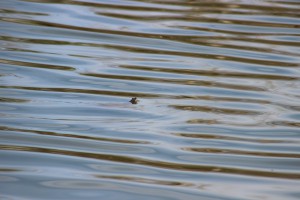
Numerous turtles can be found swimming and basking in the pond behind the butterfly house.
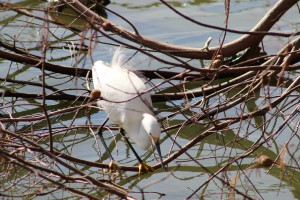
A snowy egret hunts for a meal in the turtle pond behind the butterfly house.
Nature Notes: Sea Turtles
Who doesn’t love sea turtles! These silent, charismatic creatures have been navigating Gulf waters, and nesting on our beaches for centuries. Certainly the largest species of turtle humans will encounter, weighing in between 200-300 pounds – with some reaching 1000 pounds, they are an awesome thing to see. There are five species found in the northern Gulf of Mexico and there are records of four them nesting here. Those species are the Loggerhead, Green, Kemp’s Ridley, Hawksbill, and the giant of them all the Leatherback.
Sea turtles begin their lives within the egg buried on a beach. The sex of the embryo is determined by the temperature of the sand they are incubating in – cold ones become males and 29°C appears to be the cutoff. After 60-70 days incubating the young hatchlings emerge at night and orient towards shortwave light (moon or stars off the water). However, in recent years much of the light we provide in our homes as directed them in the wrong direction (disorientation). There are “turtle friendly lights” that use longwave colors and significantly reduce the disorientation problem. All coastal counties along the panhandle require these lights for island structures. Many of the hatchlings are lost as they wonder to the Gulf. Ghost crabs, fox, coyotes, and now feral cats capture and consume many.
Those lucky enough to reach the water now have to deal with fish and bird predators. These young head offshore seeking the Sargassum mats where they will spend their growing years feeding and hiding.
As immature adults most species will return to the coastal areas to feed on seagrasses or invertebrates. As they become sexually mature they, once again, head to sea. Though they travel far and wide they are known to return to their place of birth for breeding and egg laying. Breeding takes place just offshore and females may come ashore more than once to deposit their clutch of 100+ eggs.
In addition to light pollution, marine debris, boat strikes, commercial fishing nets, and even holes and chairs left on the beach overnight have caused their numbers to decline. You should be aware that most coastal counties have a “leave no trace” ordinance asking you to remove your chairs, tents, and other items at the end of the day – and please fill in any holes you may have dug. All species of marine turtles are currently listed and protected by the U.S. Fish and Wildlife Service. In Florida, the USFWS has yield management of these species to the Florida Fish and Wildlife Conservation Commission. They are truly a magnificent creature and we hope all get to see one while exploring our beaches.
Now it is time to move to Okaloosa County – the April issue will look at Ft. Walton and Destin. Let’s head there and see what cool outdoor adventures await us.
You can find information on ecotourism providers in Escambia and Santa Rosa counties by visiting Naturally EsacRosa.

by Laura Tiu | Mar 12, 2016
It is that time of year again. Spring Break brings locals and visitors back to the beach for fun in the sun. It is important to remind folks that part of having fun is playing it safe. At the beach, this means knowing and following some pretty basic safety guidelines.
Not all beaches have lifeguards present, you have to be responsible for your own safety. When visiting the beach, it is important to consider the tide and surf conditions. To minimize the risks of drowning or serious injury, a uniform warning flag program was developed for use by Florida’s beachfront communities. Florida’s beach warning flag program uses flags in four colors accompanied by interpretive signs along the beach to explain the meaning of each color in both English and Spanish. Please follow the guidelines and flags posted.
You also need to check for the presence of rip currents. Rip currents are powerful currents of water moving away from the shore. They can pull even a strong swimmer out to sea. It is best to not enter the water where a rip current is present. However, if you find yourself caught in one, try to relax and don’t fight the current, swim out of the current parallel to the shore and swim to shore when you no longer feel the pull of the current.
Protect your skin. Just one blistering sunburn in childhood or adolescence more than doubles a person’s chance for developing melanoma later in life. Racking up more than five sunburns at any age also doubles the risk for melanoma. Keep sunburn at bay by properly applying sunscreen of SPF 15 or higher. Try to spend some time in the shade, wear a hat and sunglasses to protect your eyes. Remember to hydrate by drinking plenty of water too.
It is good to know a little bit about and appreciate the ocean life you might meet on the beach. Shark attacks aren’t common, especially in shallow shore areas, but always be on the lookout. Shells on mussels, clams and oysters can be very sharp so be careful walking near them. Some species of jellyfish have tentacles that contain venom and can sting you. Avoid them if you can. Learn about the animals you will find at the beach and you will be able to co-exist with little risk.
Many ocean creatures need our protection. Sea turtles and many shorebirds are protected and there are things you can do to help them. For sea turtles, keep the beach clean (remove all trash and furniture), dark (turn off lights on beach and don’t use flashlights) and flat (fill in any holes you dig so that turtles don’t become trapped). In fact, it’s recommended that you take only pictures and leave only footprints. Stay away from nesting shorebird habitat. Many beaches do not allow you to bring your pets to the beach for health and safety reasons and to protect venerable wildlife. Be sure to know the rules before you bring Fido to the beach.
Finally, please help keep the beach tidy. When your visit is over, take back everything you brought. Food scraps attract unwanted animals, fishing line injures and kills birds and other wildlife and plastic is harmful to both the environment and the animals that sometimes mistake it for food. Abandoned beach furniture and toys can obstruct sea turtle nesting and hatching. The best policy is to leave the beach cleaner than you found it.
Have a good time at the beach. Take a little time to learn and follow the safety rules that are there for your protection. Practice good citizenship by caring for and conserving the beach and ocean ecosystems in order to keep them beautiful in the present and for future generations.
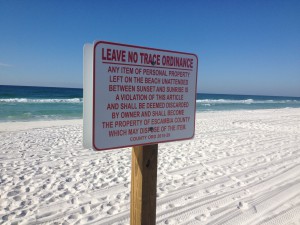
Many counties in the panhandle have lighting and barrier ordinances to protect wildlife and workers.
Photo: Rick O’Connor
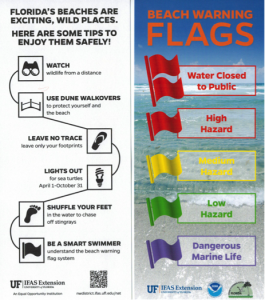
Follow these beach safety tips for helping your family enjoy the beach while protecting coastal wildlife.
















































